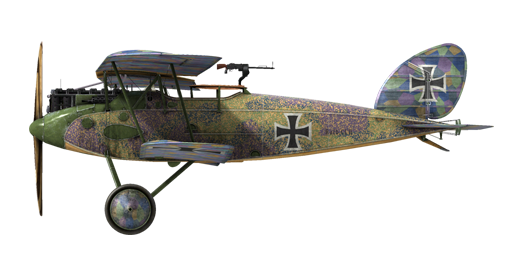il2
Halberstadt CL.II 200hp

Description
Halberstadt CL.II design was a response to an Idflieg (Inspectorate of Aviation Troops) specification issued in august of 1916 for a new “light C-type” with 160-180 engine.
The purpose was to create a two-seat escort fighter to protect heavier observation aircraft from attacks of allied fighters. In November of 1916 Idflieg ordered three prototypes of the Halberstadt CL.II with Mercedes D.III engine, with the first ready airplane was rolled out in April of 1917. After a few wing design changes the type was undergoing final tests in Adlesdorf during 2-7 May 1917.
Deliveries of machines into frontline service begin by August 1917, being supplied mostly to Schutzstaffeln (Protection flights), and Schlachtstaffeln (Ground attack flights). Its climb and maneuverability was excellent and it was regarded by its crews as very close to such single-engined fighters as the Albatros D.III/V. While the airplane was able to carry photo and radio installations, and primarily used as escort fighter, it was also used as ground attack aircraft. Because of its good maneuverability and ability to rapidly change flight altitude it was able to avoid enemy ground fire, and was successfully used to hit enemy ground troops and other frontline installations.
Because of its good performance and ability to hold itself against enemy fighters, and being light and comfortable to fly, the CL.II was preferred by pilots over all other types and remained in service throughout the whole war, serving together with new airplane types.
It is not exactly known exactly how many of the CL.II were built, but the production orders of 900 machines correspond to six Idflieg production orders for Halberstadter Flugzeugwerke, plus around of 300 machines by Bayerische Flugzeug Werke AG (in two orders), so it's approximately 1200 machines in total.
Mercedes D.IIIaü engine had improved performance at higher altitudes, but setting the throttle to full at low altitudes could cause detonation in the engine.
Engine: 6—cyl. inline Mercedes D.IIIaü
Power: 200 hp
Dimensions:
Height: 2750 mm
Length: 7300 mm
Wing span: 10770 mm
Wing surface: 27.5 sq.m
Weight:
Empty: 735 kg
Crew: 160 kg
Fuel capacity: 155 liters (115 kg)
Oil capacity: 28 liters (22 kg)
Takeoff without bombload: 1032 kg
Takeoff with 3 x 50 kg bombs: 1182 kg
Takeoff with 12 x 12,5 kg bombs: 1182 kg
Speed (IAS), without bombload:
sea level - 174 km/h
1000 - 164 km/h
2000 - 154 km/h
3000 - 144 km/h
4000 - 132 km/h
5000 - 120 km/h
6000 - 100 km/h
Climb rate, full fuel load, no bombs:
1000 m - 4 min. 20 sec.
2000 m - 9 min. 38 sec.
3000 m - 16 min. 44 sec.
4000 m - 27 min. 27 sec.
Service ceiling: 4900 m
Theoretical ceiling: 6100 m
Endurance at 1000 m:
nominal power (combat) — 3 h.
minimal consumption — 6 h. 40 min.
Armament:
Forward firing: 1 х LMG 08/15 Spandau 7,92 mm, 500 rounds
Turret: 1 х LMG 14/17 Parabellum 7,92 mm, 3 boxes with 250 rounds each.
Bomb load variations:
12 x 12.5 kg (150 kg)
1 x 50 kg + 8 x 12.5 kg (150 kg)
3 x 50 kg (150 kg)
4 x 12.5 kg (50 kg)
1 x 50 kg (50 kg)
150 kg in total.
References
1) Schlachtflieger by Rick Duiven, Dan-San Abbott.
2) Report on the Halberstadt Fighter, October 1918, Flight.
3) Windsock Datafile 27 Halberstadt CL.II P.M. Grosz.
Modifications
Additional Gauges
Wilhelm Morell Anemometer (45-250 km/h)
D.R.G.M liquid Inclinometer (indicates bank while on ground and sideslip while in flight)
A.Schlegelmilch engine coolant temperature indicator (0-100 °C)
Mechanical Clock
Additional mass: 3 kg
20mm Becker Turret
Turret with Becker Automatic Cannon
Ammo: 60 of 20mm rounds (4 magazines with 15 rounds in each)
Ammo type: HE/AP (High Explosive and Armour Piercing rounds)
Rate of fire: 300 rpm
Projectile weight: 120/130 g
Muzzle velocity: 450/490 m/s
Gun weight: 30 kg
Mount weight: 10 kg
Ammunition total weight: 25 kg
Total weight: 65 kg
Estimated speed loss: 6 km/h
Cockpit light
Cockpit illumination lamp for night sorties
Additional mass: 1 kg
Twin Spandau MG
Twin fixed forward firing LMG 08/15 guns.
Ammo: 1000 of 7.92mm rounds (500 rounds for each gun)
Projectile weight: 10 g
Muzzle velocity: 825 m/s
Rate of fire: 650 rpm
Guns weight: 26 kg
Mount weight: 8 kg
Ammo weight: 20 kg
Total weight: 54 kg
Estimated speed loss: 4 km/h
Radio
Radio transmitter
Additional mass: 10 kg
Aldis (Trophy)
Aldis Refractor-type Collimator Sight
Additional mass: 2 kg
Camera
Camera for taking aerial photographs
Additional mass: 10 kg
P.u.W. Bombs
Up to 12 x 12.5 kg P.u.W. General Purpose Bombs
Additional mass: 186 kg
Ammunition mass: 150 kg
Racks mass: 36 kg
Estimated speed loss before drop: 4 km/h
Estimated speed loss after drop: 2 km/h
Up to 3 x 50 kg P.u.W. General Purpose Bombs
Additional mass: 186 kg
Ammunition mass: 150 kg
Racks mass: 36 kg
Estimated speed loss before drop: 4 km/h
Estimated speed loss after drop: 2 km/h
Twin Parabellum MG Turret
Ring turret with twin Parabellum machine guns.
Ammo: 1500 of 7.92mm rounds (6 drums with 250 rounds in each)
Projectile weight: 10 g
Muzzle velocity: 825 m/s
Rate of fire: 700 rpm
Guns weight: 19 kg (w/o ammo drums)
Mount weight: 5 kg
Ammo weight: 30 kg
Total weight: 54 kg
Estimated speed loss: 8 km/h